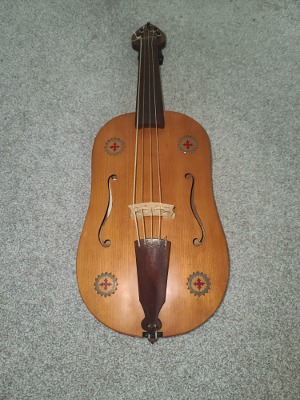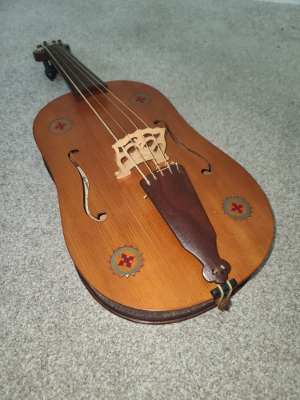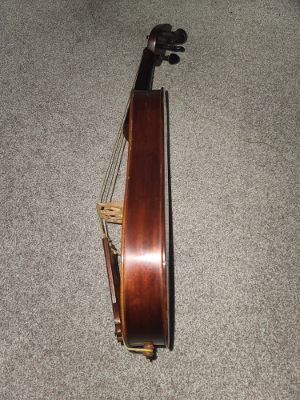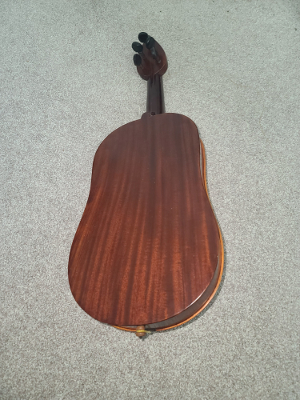
bout the Vielle
 A vielle is a bowed string instrument.
It has many common features of the violin: it has a neck, which is topped with a peg box; strings that run down the length of the instrument from the peg box; a bridge to support the strings; a tail piece; and a body with sound holes.
However, in many instances these features look somewhat different than they do on a modern violin.
A vielle is a bowed string instrument.
It has many common features of the violin: it has a neck, which is topped with a peg box; strings that run down the length of the instrument from the peg box; a bridge to support the strings; a tail piece; and a body with sound holes.
However, in many instances these features look somewhat different than they do on a modern violin.
Vielles developed in Medieval Europe. Johannes de Grocheio writes in about stringed instruments and specifically vielles in his text Ars Musicae c.1300. He states "Nos autem hic non intendimus instrumentorum compositionem vel divisionem nisi propter diversitatem formarum musicalium que in eis generantur. Inter que instrumenta cum cordis principatum optinent. ... Et adhuc inter omnia instrumenta cordosa visa a nobis, viella videtur prevalere." Thus, we learn that by the 14th century, stringed instruments were used in a wide variety of types of music, and vielles were used more than other stringed instruments. Despite their prevalence, no vielles from that time have survived. We know of vielles through illustrations, sculptures, and writings. (One of the earliest extant European stringed instruments is the violeta of St. Catherine de Vigri from the late 15th century. (Saxon lyres being much older.) There are numerous instruments from the 16th century including Lira da Braccio by Giovanni Maria da Bresciam and the fragments of fiddles from the King Henry the VIIIths sunken warship, the Mary Rose.)
Vielles varied greatly in size and shape. The largest vielles come from some of the earliest sources. Biblioteca National de Espana Vitr. 14/1. Folio 130r. depicts several people with large vielles. The instruments are quite big, almost as tall as the figures. They are being held in an upright position beside the musicians with one hand holding the neck of the instrument and the other hand holding an arc shaped bow. This particular illustration is historically important as the earliest depiction of a bowed string instrument, aside from the painting in the Trois Frères cave in France of a man dressed in a bison costume with what could be a musical bow. The vast majority of depictions of vielles are a bit larger than a modern viola. Some are smaller than a violin. In general they are larger than rebecs. This is corroborated in written accounts as well. In his treatise De inventione et usu musice, Johannes Tinctoris describes the rebec as very small.
The body of a prototypical vielle is roughly oval shaped. This style body is depicted in Bibliotheque Municipale, Lunel, France, MS. I, folio 6r c. 1150, as well as later sources such as the Cantigas de Santa Maria c. 1280, the Peterborough Psalter c. 1315, and Codex Manesse, UB Heidelberg, c. 1305-1315. This body distinguished the vielle from the rebec, whose body is more like a teardrop, and thus is not symetrical top to bottom. However, many different and elaborate body shapes existed throughout the Medieval and Renaissance eras. Some were decorative, such as being shaped like a leaf, such as the one in The Hours of Charles the Noble Cleveland Museum of Art 64.40, fol. 277r. Others were more practical, being shaped like a figure 8. (This allowed the end strings to be bowed separately.) A sculpture from the portal of glory in Santiago de Compostella Cathedral, c.1168, depicts several vielles with a figure 8 shaped body. (They are next to the organistrum.) In that same sculpture there were also vielles with oval bodies. One may argue that they were distinct types of instruments. However, during the fifteenth century vielle came to be used to refer to hurdy gurdies. In the Compostella sculpture we see the figure 8 shaped vielles next to the organistrum, a predecessor of the hurdy gurdy. Thus I would argue that there was not a linear evolution from an oval body to a figure 8, not moving from oval eventually to the waisted shape of a violin. Illustrations of vielles from the 15th century continue to show variations including a rectangular body, which is similar to the fiddles from the Mary Rose, and waisted instruments somewhat similar in shape to a guitar.
Rebecs have a bowl shaped body. Vielles do not. This can be seen in David's Greatest Triumph, c. 1244-1254, from MS M.638 'Crusader Bible', f.039v currently in the Morgan Library & Museum, New York. We clearly see that the back of the vielle has an edge, thus the instrument is not bowl backed.
A typical vielle has a leaf shaped peg box with pegs above or behind the surface, as opposed to the side like a modern violin. However, again, many styles existed. Vielles were also adorned with carved heads atop the peg box. Examples include the a sculpture at Beverley Minster, c. 1335-50 and Pluto and Persephone enthroned from Le livre des échecs amoureux moralisés in Bibliotheque Nationale, Paris (BNF Fr 143). This tradition continued. It can be seen centuries later in the lion headed violins from Germany.
Vielles are commonly depicted with four or five strings. There are many examples of bridges that are flat and short. Some instruments have a bourdon, or drone.
An illustration in Boethius, De Arithmetica. Naples, Biblioteca Nazionale, MS V.A.14, fol. 47r. shows that the side of the body of the instrument is routed out into a c shape. It does not appear that such carving are separate ribs. Rather the body is carved from a single piece of wood. Later instruments such as the Lira da Braccio by Francesco Linarol c.1563, have such scooped sides.
Early sources illustrate the instrument being played upright, like a cello, with the bottom resting on a person's thigh. In later sources, from the 14th century onwards, the instrument is predominately played da braccio, in the arms, somewhat like a modern violin.
The term vielle is French. Its earlier history is not certain. It may be derived from Old Occitan viola, and in turn from Medieval Latin Vitula (The Roman goddess of joy and victory or a female calf). It may also be derived from Proto-West Germanic fiþulā. Vielle is closely related to other terms in a wide variety of languages that all mean a stringed instrument. In Old High German there is fidala and fidula. In Middle High German these became videle, fidele, fidel In Old English there was fiþele. Middle English had many versions including fedele, fedle, fethele, ffythil, ffythele, fieþle, fiþele, fithele, fithel, fydell, phetele, phethele, and viþele. In Italian it was viol, or viola. In Spain it was vihuela. The modern terms fiddle and viola are derived from this group of words.
I will leave for another time to discuss the tuning of the vielle.
The instrument pictured here was made by Bernie Lehmann in the 1980s. The back is made from mahogany. The top is spruce. It is based on Hans Memling’s triptych Christ with Singing and Music-Making Angels. That painting dates from the 1480s and is currently in the Royal Museum of Fine Arts in Antwerp. It is MKSKA 780.


Page Design Copyright 2010 Michael Berger
Clip Art Copyright 2002 Dover Publications




